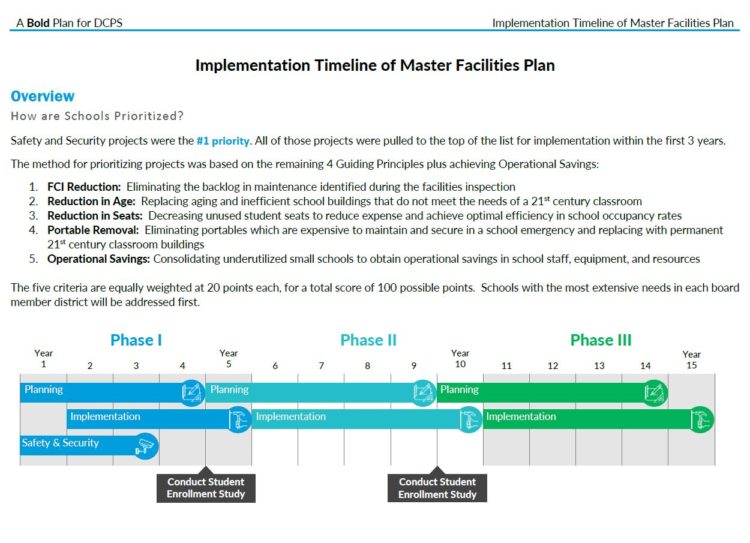Aug. 27, 2019 – Focusing on the priorities of improving school safety and security, eliminating backlogged maintenance, reducing the age of schools, consolidating schools to reduce seats and save operating dollars, and removing portables, Duval County Public Schools has applied its evaluation methodology to each proposed school project included in its Master Facility Plan approved by the School Board in July.
The result of that evaluation process enables the public to see how the Master Facility Plan is currently projected to be deployed throughout the district over the 15-year life of the proposed half-penny sales surtax.
Under the plan, every district school will receive its safety and security improvements within three years if the referendum for a half-penny surtax is placed on the ballot and approved by Duval County voters.
“The release of this timeline today demonstrates our ongoing effort to meet the requests of city council members,” said School Board Chairwoman Lori Hershey. “It is my hope that both the public and City Council see the implementation of our master plan meets the overall goals of the plan and deploys resources appropriately to improve the educational experience for all students in Duval County Public Schools.”
The district notes that plan priorities could change pending changes in enrollment trends or any significant maintenance failures or other impacts to its buildings.
“Earlier this summer, the two building chillers at one of our elementary schools failed at the same time,” said Dr. Diana Greene, Superintendent of Schools. “Unforeseen and unpredictable building systems failures or other events could alter the priorities.”
Following the commitment to improve safety and security at all schools, the district evaluated each school improvement project based on its ability to meet these objectives:
- Reduce maintenance backlog.
- Reduce overall district building average age.
- Reduce student seats through school consolidation.
- Remove portables.
- Create operational savings.
Each category was equally weighted at 20 points each. Those projects with the highest score in each Board member’s district rose to the top. Following this primary analysis, plans were then ordered appropriately to accommodate relevant logistical needs.
Certain projects must be completed before others can begin to ensure continuous school operations.
“Organizing this by Board member district makes sense,” Dr. Greene said. “It enables us to manage the complex logistics required when we begin major school building projects in a region, and it enables work to begin on priorities throughout the county.”
To ensure equity throughout the district, the projected revenue from the proposed sales surtax is being assigned on a proportional basis in accordance with the Facility Condition Index of all the schools in that board member district. This enables the district to channel the funding to the schools that are in the worst condition and ensures all schools get the funding they need to fix their problems.
If the sales surtax is approved by voters, the implementation of the priorities and the Master Facility Plan will be monitored by a citizen oversight committee being appointed by the School Board. The committee will provide accountability and transparency to the process.








